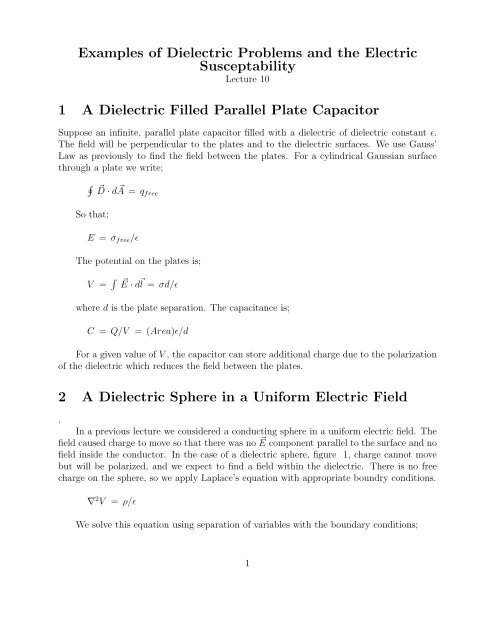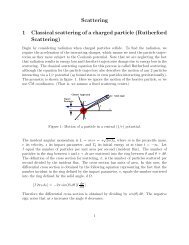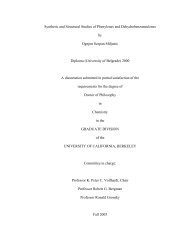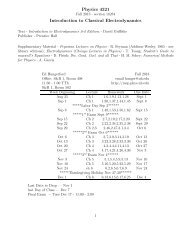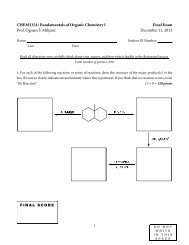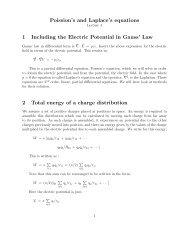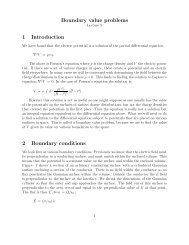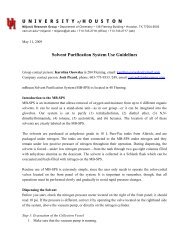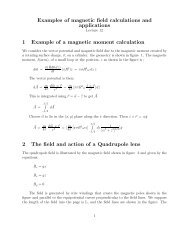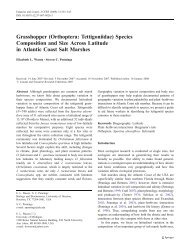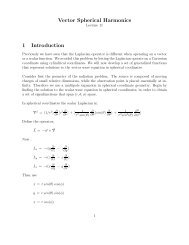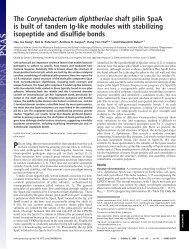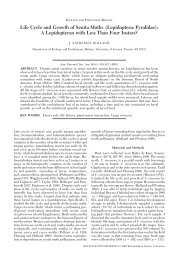Examples of Dielectric Problems and the Electric Susceptability 1 A ...
Examples of Dielectric Problems and the Electric Susceptability 1 A ...
Examples of Dielectric Problems and the Electric Susceptability 1 A ...
You also want an ePaper? Increase the reach of your titles
YUMPU automatically turns print PDFs into web optimized ePapers that Google loves.
<strong>Examples</strong> <strong>of</strong> <strong>Dielectric</strong> <strong>Problems</strong> <strong>and</strong> <strong>the</strong> <strong>Electric</strong><strong>Susceptability</strong>Lecture 101 A <strong>Dielectric</strong> Filled Parallel Plate CapacitorSuppose an infinite, parallel plate capacitor filled with a dielectric <strong>of</strong> dielectric constant ǫ.The field will be perpendicular to <strong>the</strong> plates <strong>and</strong> to <strong>the</strong> dielectric surfaces. We use Gauss’Law as previously to find <strong>the</strong> field between <strong>the</strong> plates. For a cylindrical Gaussian surfacethrough a plate we write;∮ ⃗D · d ⃗ A = qfreeSo that;E = σ free /ǫThe potential on <strong>the</strong> plates is;V = ∫ ⃗ E · d ⃗ l = σd/ǫwhere d is <strong>the</strong> plate separation. The capacitance is;C = Q/V = (Area)ǫ/dFor a given value <strong>of</strong> V , <strong>the</strong> capacitor can store additional charge due to <strong>the</strong> polarization<strong>of</strong> <strong>the</strong> dielectric which reduces <strong>the</strong> field between <strong>the</strong> plates.2 A <strong>Dielectric</strong> Sphere in a Uniform <strong>Electric</strong> Field.In a previous lecture we considered a conducting sphere in a uniform electric field. Thefield caused charge to move so that <strong>the</strong>re was no E ⃗ component parallel to <strong>the</strong> surface <strong>and</strong> n<strong>of</strong>ield inside <strong>the</strong> conductor. In <strong>the</strong> case <strong>of</strong> a dielectric sphere, figure 1, charge cannot movebut will be polarized, <strong>and</strong> we expect to find a field within <strong>the</strong> dielectric. There is no freecharge on <strong>the</strong> sphere, so we apply Laplace’s equation with appropriate boundry conditions.∇ 2 V = ρ/ǫWe solve this equation using separation <strong>of</strong> variables with <strong>the</strong> boundary conditions;1
ε oE = Eo r cos( θ ) z^E = Eo r cos( θ ) z^εE = Eo r cos( θ ) z^E = Eo r cos( θ ) z^Figure 1: The geometry <strong>of</strong> a dielectric sphere placed in a uniform fieldV = E 0 z = E 0 r cos(θ) as r → ∞E is finite as r = 0E ⊥ = (ǫ/ǫ 0 ) E ′ ⊥ , <strong>and</strong>;E ‖ = E ′ ‖ at r = aIn spherical coordinates <strong>the</strong> solution with azmuthal symmetry has <strong>the</strong> form;For r < aFor r > aV = (κ/r ′ ) ∑ A l ( r r ′ ) l P l (x)V = (κ/r) ∑ B l ( r′r )l P l (x)In <strong>the</strong> above, x = cos(θ) . Apply <strong>the</strong> boundry conditions to obtain <strong>the</strong> equation;V = (κ)[A 0 + A 1 r ′ cos(θ)] for r < aV = (κ/r)[B 0 + B 1 /r cos(θ) − V 0 rcos(θ)] for r > aAll o<strong>the</strong>r c<strong>of</strong>ficients must vanish to satisfy <strong>the</strong> boundary conditions as r → ∞ <strong>and</strong> r → 0.Then match <strong>the</strong> field as r = a with ⃗ E = −ǫ ⃗ ∇V2
ǫ ∂V∂r in = ǫ 0 ∂V∂r outThen we have ǫ r = ǫ/ǫ 0 which gives;ǫ r∑Al a l−1 P l = − ∑ B l (l + 1) a −(l+2) P l − E 0 cos(θ)The requirement that tangential E is continous is equivalent to <strong>the</strong> continuity <strong>of</strong> <strong>the</strong>potential.∑Al a l P l = ∑ B l a −(l+1) P l − E 0 P lEquate <strong>the</strong> constants;A 0 = B 0 /a <strong>and</strong> B 0 a −2 = 0A 1 a = B 1 a −2 − E 0 a <strong>and</strong> −ǫ r a 1 = 2B 1 a −3 + E 0A 2 a 2 = B 2 a −3 <strong>and</strong> −ǫ r aA 2 = −3B 2 a −4This means that ;B 0 = 0; A 0 = 0A 1 = B 1 /a 3 − E 0All o<strong>the</strong>r values <strong>of</strong> A l <strong>and</strong> B l are zero. Finally;B 1 = (ǫ r − 1)(ǫ r + 2) a3 E 0A 1 = − 3(ǫ r + 2) E 0The potential is <strong>the</strong>n;r < aV = − 3(ǫ r + 2) r cos(θ)r > aV = −E 0 rcos(θ) + (ǫ r − 1)(ǫ r + 2) E 0 (a/r) 3 r cos(θ)3
σE zθ EFigure 2: The geometry used to find <strong>the</strong> field at <strong>the</strong> center <strong>of</strong> <strong>the</strong> polarized sphere3 Polarization <strong>of</strong> <strong>the</strong> <strong>Dielectric</strong> Sphere in a Uniform<strong>Electric</strong> Field.The field inside <strong>the</strong> dielectric sphere as obtained in <strong>the</strong> last section is;⃗E = − ⃗ ∇Vwith V in = − 3E 0(ǫ r + 2) r cos(θ)Thus ⃗ E = 3E 0(ǫ r + 2) ẑThe field is uniform <strong>and</strong> in <strong>the</strong> ẑ direction. The volume charge density is given byρ = − ⃗ ∇ · ⃗P, but <strong>the</strong> field within <strong>the</strong> sphere is constant. The Polarization is given by;⃗P = (ǫ − ǫ 0 ) ⃗ EThus <strong>the</strong> volume charge density vanishes. There is a surface charge density given by;σ = ⃗ P · ˆn = P cos(θ)where ˆn is <strong>the</strong> outward surface normal. The field inside <strong>the</strong> sphere is due to <strong>the</strong> surface4
charge <strong>and</strong> in fact forms a dipole field. We calculate this field at <strong>the</strong> center <strong>of</strong> <strong>the</strong> sphere 2.The field due to <strong>the</strong> small element as shown in <strong>the</strong> figure is;dE z = −κ P cos(θ)r 2cos(θ) r 2 dΩIntegrate this over <strong>the</strong> solid angle dΩ;E z = − ⃗ P3ǫ0This field is <strong>the</strong> same for all points in <strong>the</strong> sphere as we have found that <strong>the</strong> field isconstant. Note that it is directed opposite to <strong>the</strong> applied field.4 Connection between <strong>the</strong> <strong>Electric</strong> Susceptibility <strong>and</strong>Atomic PolarizabilityAn applied field induces a polarization in a dielectric material. To better underst<strong>and</strong> thisprocess consider <strong>the</strong> polarization at <strong>the</strong> center <strong>of</strong> a ploarized spherical dielectric. We <strong>the</strong>ncombine <strong>the</strong> Polarization to <strong>the</strong> applied field to obtain;⃗E = ǫ 0⃗ E + ⃗ P = ⃗ D = ǫ ⃗ EWe <strong>the</strong>n combine <strong>the</strong> Polarization to <strong>the</strong> applied field to obtain;⃗E = ǫ 0⃗ E + ⃗ P = ⃗ D = ǫ ⃗ EIn this case <strong>the</strong> polarization is independent <strong>of</strong> surface effects. Assume <strong>the</strong> applied fieldis ⃗ E 0 <strong>and</strong> ⃗ E ′ <strong>the</strong> field due to <strong>the</strong> polarized material. The total field inside <strong>the</strong> dielectricis <strong>the</strong> superposition <strong>of</strong> <strong>the</strong>se fields. It is <strong>the</strong> total field that causes <strong>the</strong> polarization ie <strong>the</strong>polarization field also causes polarization so <strong>the</strong> effect is non-linear (self interaction). Thefield in <strong>the</strong> dielectric is, ⃗ E total .E total = ⃗ E 0 + ⃗ E polThe field at <strong>the</strong> center <strong>of</strong> <strong>the</strong> dielectric sphere as solved above is;E z = − P3ǫ 0The dipole moment <strong>of</strong> <strong>the</strong> sphere is obtained from <strong>the</strong> atomic polarizability, α.5
⃗p = α ⃗ E 0 = α( ⃗ E total + ⃗ P3ǫ0)The polarization is <strong>the</strong> dipole moment per unit volume, ⃗ P = N⃗p, where N is <strong>the</strong> numberdensity <strong>of</strong> dipoles. Now solve for <strong>the</strong> polarization.⃗P =Nα1 − P/(3ǫ 0 ) ⃗ E volumeThe electric susceptibility χ e is;χ e =Nα(1 − P/3ǫ 0 )Then <strong>the</strong> field inside <strong>the</strong> sphere from <strong>the</strong> previous solution is3E 0ǫ r + 2. The applied fieldis E 0 , so that neglecting vectors as all fields are in <strong>the</strong> ẑ direction;E pol = 3E 0ǫ r + 2 − E 0 = − ǫ r − 1ǫ r + 2 E 0Note to first order <strong>the</strong> polarization is, P 1 ;P 1 = ǫχ e E 0 = (ǫ r − 1)ǫ 0 E 0This does not equal <strong>the</strong> polarization above, P ≠ P 1 so that <strong>the</strong> polarization acts to createnew polarization (ie a non-linear effect). We can iterate <strong>the</strong> first order result obtaininga first order polarization field, E 1E 1 = P 13ǫ= − (ǫ r − 1)0 3E 0This creates an incremental polarization, P 2 ;P 2 = (ǫ r − 1)ǫ 0 E 1 = (ǫ r − 1) 23ǫ 0 E o<strong>and</strong> this creates an additional E field;E 2 = −( ǫ r − 13) 2 E 0Continuing <strong>the</strong> iterations;⃗P = 3 ∑ n(− ǫ r − 13) n ǫ 0E0 ⃗ = 3(ǫ r − 1)ǫ r + 2 ǫ ⃗ 0E 0To summarize, we have found <strong>the</strong> solution for a dielectric in a uniform electric field in<strong>the</strong> interior <strong>of</strong> <strong>the</strong> sphere to have <strong>the</strong> form;6
⃗E in = 3E 0ǫ r + 2From <strong>the</strong> definition <strong>of</strong> <strong>the</strong> electric displacement, ⃗ D = ǫ 0⃗ E + ⃗ P so that;⃗P = ǫ 0 (ǫ r − 1) ⃗ EFor <strong>the</strong> dielectric sphere, E z = − P3ǫ 0, which when subsituted for E z above;P = ǫ 0 (ǫ r − 1) 3E 0ǫ r + 2 E 0This is <strong>the</strong> expected result.5 Energy in a <strong>Dielectric</strong>For a parallel plate capacitor filled with a dielectric constant, ǫ, <strong>and</strong> plate separation, d. Thecapacitance is ;C = Q/VV = EdC = Q/EdUse Gauss’s Law to get E;∮ ⃗D · d ⃗ A = QfreeE = σ/ǫC = ǫ(Area)/dWithout <strong>the</strong> dielectric <strong>the</strong> capacitance isC 0 = ǫ 0 (Area)/dTherefore;C = ǫ r C 0 = ǫ 0E t + PE tC 07
In <strong>the</strong> above, E t is <strong>the</strong> total field in <strong>the</strong> capacitor. From this we can obtain;ǫ r = (ǫ 0 + P/E t ) = ǫ 0 (1 + χ e )The above equation connects <strong>the</strong> permittivity (dielectric constant) to <strong>the</strong> susceptibility.The energy <strong>of</strong> a parallel plate capacitor is obained by;W = 1/2 CV 2 = 1/2 ǫ r C 0 V 2W = (ǫ/2) ∫ dτ E 2When one keeps <strong>the</strong> same voltage across <strong>the</strong> capacitor, <strong>the</strong>re is an increase in energyW = ǫ r W 0 in a dielectric filled capacitor. Look at this additional energy. The differentialenergy to align a dipole, as previously obtained is ;dW = E dpThen use <strong>the</strong> dipole density, N, to obtain <strong>the</strong> potential energy per unit volume due to<strong>the</strong> polarization, ⃗ P = N⃗p.∫dW =∫dP E =∫dE ǫ0 (ǫ r − 1)EW = (1/2)ǫ 0 (ǫ r − 1)E 2This is to be added to <strong>the</strong> energy density <strong>of</strong> <strong>the</strong> vacuum field (ǫ 0 /2)E 2 which gives <strong>the</strong>expected result (ǫ/2)E 2 . Thus <strong>the</strong> additional energy is stored in <strong>the</strong> polarization <strong>of</strong> <strong>the</strong>material.6 Example <strong>of</strong> Energy in a <strong>Dielectric</strong>Suppose a charged parallel plate capacitor is dipped into a dielectric liquid. The liquidmoves up into <strong>the</strong> capacitor. The final position <strong>of</strong> <strong>the</strong> liquid can be determined by minimizing<strong>the</strong> system energy. The geometry is shown in figure 3. In this problem <strong>the</strong> voltageis disconnected from <strong>the</strong> capacitor so <strong>the</strong> charge remains constant, but <strong>the</strong> voltage changesas <strong>the</strong> liquid fills <strong>the</strong> volume between <strong>the</strong> plates. On <strong>the</strong> o<strong>the</strong>r h<strong>and</strong>, if <strong>the</strong> voltage supplyremains connected to <strong>the</strong> capacitor, <strong>the</strong>n <strong>the</strong> voltage remains constant, but <strong>the</strong> chargechanges. As in <strong>the</strong> figure, <strong>the</strong> system consists <strong>of</strong> 2 capacitors in parallel. Assume <strong>the</strong> width<strong>of</strong> <strong>the</strong> capacitor plates is w. The capacitance values for each capacitor are;.8
εldhFigure 3: A parallel plate capacitor dipped into a dielectric liquidC 1 = ǫ 0w(l − h)dC 2 = ǫwhhSo that <strong>the</strong> system capacitance is C t = C 1 + C 2 .C t = C 0 [1 + (h/l)(ǫ r − 1)]Where we have used C 0 = ǫ 0lwd. The energy stored in <strong>the</strong> capacitor as a function <strong>of</strong> h is;W =Q 22C 0 [1 + (h/l)(ǫ r − 1)]Since ǫ r > 1 <strong>the</strong> energy decreases as h increases. The difference in <strong>the</strong> energy goes intoraising <strong>the</strong> liquid. The system energy is <strong>the</strong>n;W S = W + mg(h/2) = W + g(h/2)ρ(wdh)In <strong>the</strong> above ρ is <strong>the</strong> mass density. The minimum in <strong>the</strong> energy is <strong>the</strong>n found to obtain<strong>the</strong> equilibrum position.∂W S∂h = 0Q−2 l(ǫ r − 1)2C 0 [l + h(ǫ r − 1)] 2 + 2ρwd(h/2) = 0Solve for h to find <strong>the</strong> equilibrum position. This results in a cubic equation for h.9
zεεoxqayFigure 4: The geometry <strong>of</strong> a problem with a point charge q placed at <strong>the</strong> center <strong>of</strong> a sphericaltank <strong>of</strong> waterh 3 +2 l(ǫ r − 1) h2 +l 2(ǫ r − 1) 2 −2Q 2 l4ρw 2 ǫ 0 (ǫ r − 1)C 0= 0There is one real root <strong>of</strong> <strong>the</strong> equation if q 3 + r 2 > 0 where;q = −(1/3)[ lǫ r − 1 ]2r = (1/9)( l2Q(ǫ r − 1) )3 − (3/4)2 lρw 2 gǫ 0 (ǫ r − 1)Which will be <strong>the</strong> case in physical situations.7 Point Charge placed at <strong>the</strong> center <strong>of</strong> a SphericalTank <strong>of</strong> Water.The geometry <strong>of</strong> <strong>the</strong> problem is shown in figure 4. We use Gauss’ law to get <strong>the</strong> electricdisplacement in <strong>the</strong> water. The electric displacement (<strong>and</strong> electric field) is radial <strong>and</strong>independent <strong>of</strong> angle. Thus;∮ ⃗D · d ⃗ A = Qfree = qThus because <strong>of</strong> symmetry;10
⃗D = 14π q r 2 ˆr<strong>and</strong> ⃗ D = ǫ ⃗ E. Then <strong>the</strong> polarization is,⃗P = ǫ 0 (ǫ r − 1) ⃗ E = ǫ 0 (ǫ r − 1) 14πǫ q r 2 ˆrThe Volume charge density is ;ρ = − ⃗ ∇ · ⃗P = 1 r 2 ∂ ∂r [r2 P r ] = 0Thus <strong>the</strong>re is no volume charge density. The surface charge density at r = a is;σ = ⃗ P · ˆr = ǫ 0 (ǫ r − 1) ⃗ E = ǫ 0 (ǫ r − 1) 14πǫ q a 2There is an inner induced charge symmetrically placed about q at some finite radius sothat <strong>the</strong> total induced charge sums to zero. Outside <strong>the</strong> water tank <strong>the</strong> field is <strong>the</strong> same as<strong>the</strong> field from a point charge q in <strong>the</strong> vacuum.8 Dipole placed at <strong>the</strong> center <strong>of</strong> a Spherical Tank <strong>of</strong>WaterThis problem is similar to <strong>the</strong> problem in <strong>the</strong> last section, but <strong>the</strong> point charge is replacedby a dipole aligned along <strong>the</strong> ẑ axis. The field <strong>of</strong> <strong>the</strong> dipole in vacuum is;⃗E d = κ p r 3 [2 cos(θ)ˆr + sin(θ) ˆθ]We put this dipole inside a small spherical volume <strong>of</strong> radius, b, in <strong>the</strong> center <strong>of</strong> <strong>the</strong> tankin order to keep <strong>the</strong> solution appropriately bounded as r → 0. Thus <strong>the</strong> boundry conditionsat r = b are;ǫE r (water) = ǫ 0 E r (vacuum)E ‖ (water) = E ‖ (vacuum)Therefore inside <strong>the</strong> water;⃗E(water) = p r 3 [2ǫ r cos(θ) ˆr + sin(θ) ˆθ]11
We solve for <strong>the</strong> potential in <strong>the</strong> water using separation <strong>of</strong> variables. The solution has<strong>the</strong> forms;r > aV = ∑ A l r −(l+1) P l (x)b < r < aV = ∑ [B l r −(l+1) + C l r l ]P l (x)Now match <strong>the</strong> boundary conditions at r = b.ǫ[2B 1 /b 3 − C 1 ]cos(θ) = 2ǫ 0 κp/b 3 cos(θ)(1/b)[B 1 /b 2 + C 1 b]sin(θ) = κp/b 3 sin(θ)All o<strong>the</strong>r coefficients vanish. Solve for B 1 <strong>and</strong> C 1 .B 1 = κp3ǫ r[ǫ r + 2]C 1 = 2κp3ǫ r b 3 [ǫ r − 1]This gives <strong>the</strong> potential;V =3ǫ κp [ ǫ r + 2r r 3 + 2(ǫ r − 1)b 3 r]cos(θ)From this one gets <strong>the</strong> field;⃗E = κp3ǫ r[[ ǫ r + 2r 2 + 2(ǫ r − 1)rb 3] cos(θ) ˆr +[ ǫ r + 2r 3 + 2(ǫ r − 1)b 3 ] sin(θ) ˆθ]The polrization is ⃗ P = ǫ 0 (ǫ r − 1) ⃗ E. So that <strong>the</strong> volume charge density is;ρ = − ⃗ ∇(ǫ 0 (ǫ r − 1) ⃗ Eρ = ǫ 0(ǫ r − 1) κp3ǫ r r 2 [[ 2(ǫ r + 2)r 2 − 2(ǫ r − 1)b 3 ] cos(θ) +[ ǫ r + 2r 3 + 2(ǫ r − 1)b 3 ]cos(θ)]12
ρ = ǫ 0(ǫ r − 1) κp3ǫ r r 2 [3(ǫ r + 2) + 6(ǫ r − 1)(r/b) 3 ] cos(θ)The surface charge density is;r = bσ = −(ǫ − ǫ 0 ) 8κp3ǫ r b 3 cos(θ)r = aσ = −(ǫ − ǫ 0 ) 4κp3ǫ r a 3 [ǫ r (1 − ǫ r (a/b) 3 ) + 2(a/b) 3 ] cos(θ)Matching <strong>the</strong> boundry conditions at r = a must now be carefully done. As <strong>the</strong> field doesnot → 0 as r → ∞ but has a dipole form, with <strong>the</strong> potential given by;V = 2κp(ǫ r − 1)b 3r cos(θ)This potential should be subtracted from <strong>the</strong> dipole potential <strong>and</strong> comes from <strong>the</strong> problem<strong>of</strong> defining a dipole as a point.13


